|
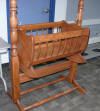 
Fred Sandoval - Cradle
Rocking the cradle Fred Sandoval explained how he
carefully mortised and aligned the joints to accommodate the slats for
the side of the cradle. The
posts, from four inch stock, required a larger than typical lathe.
The cradle is of red oak which Fred found hard to turn unless you
have sharp tools. Fred finished with Hydrocoat.
|
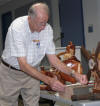
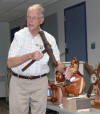
Charles Volek, WWCH Vice President and Program
Director, spoke about the deck restoration of Galveston’s tall ship,
Elissa, that occurred in 2012 and
2013. In these photos Charles demonstrates the "horsing" technique
for installing caulking. Read more
|

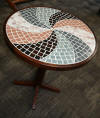
Peter Doe - Outdoor TableUsing
ipe for its weather resistance
capabilities, Peter Doe crafted this outdoor table topped with glass
mosaic tile pieces. The
tiles were glued to the top with Titebond 3 and epoxy then sealed with
three coats of epoxy finishing with three coats of spar varnish.
The tiles were cut with a carbide tipped wheel cutter and cut to
fit with a nibbler. For the legs
Peter used three jigs to make four angled cuts on the bandsaw with a
carbide tipped ¾ inch blade.
|
  

Chuck Meeder - Scroll Saw Pieces and Yarn BowlFrom
a
Sue Mey moon pattern and Wooden
Tedd Bear Collection Catalogue, Chuck Meeder scroll sawed two projects of curly maple
and mahogany then finished with spray lacquer.
The yarn bowl, finished with Mylands Friction Polish is a gift for his daughter who likes to knit
otherwise Chuck would use it for his collection of tall tales and
whoppers. The cutout allows
the yarn to be pulled out without the ball of yarn “running” away.
|
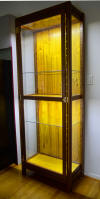 
 
David Janowitz - Display Case and BowlsTaking a lot
of time to peel off the bark from a water oak burl, David Janowitz was
able to craft this oddly shaped bowl that he finished with linseed oil
and wax finish. The smaller
bowl, which he calls “floor” wood, came from a piece found on his
father’s workshop floor. The other bowl is of osage orange.
The
display case is of osage orange and walnut finished with four
coats of water borne polyurethane.
|
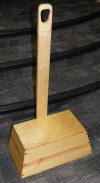

Steven Ellis - Compound Angled Step StoolWWCH
welcomed Steve Ellis as a new member as he showed club members his simple
step stool - simple being a relative term – the compound angles required
seem to defy a lot of people. The
only power tool that Steven used was a pad sander – the rest were hand
tools and helpful jigs (Steven was a carpenter). Download
Steven's instructions for
compound angles
(PDF file). Download Steven's
write-up on differences between
hip/valley rafter
(PDF file) and crown molding angles.
|
 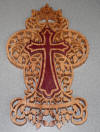

Rick Spacek - Scroll Sawed Cross and PictureFrom a
Rick Hutcheson pattern Rick
Spacek scroll sawed this beautiful cross out of inlayed oak and purple
heart. The scroll saw
picture is painted with acrylic and finished with spray clear gloss.
|
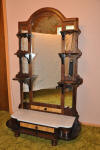 
Larry Wenner - EtagereThe original version of the
etagere was made for a tall
ceiling so Larry Wenner built this shorter version. Larry designed the
granite shelf then had it cut first. The etagere is all solid walnut
and heavy enough so it won’t fall over.
It is finished with sprayed on lacquer and is for sale for $1700
– a bargain, folks.
|
  
Rich Bajenski - Dovetailed BoxRick Bajenski crafted
this
Shaker inspired candle box using dovetail joinery and finished with
six of seven coats of
milk paint which Rick admits is
way too much.
|


Bob Wink - Folk Art From Fan Blades
Being a “fan” of the
Day of the Dead, Bob Wink
repurposed ceiling fan blades to show off Day of the Dead faces.
Bob got an “agreement” from
Norm Nichols and laughs from club
members when Bob explained that one was supposed to …. uh…. resemble
Norm.
|
  
Dave VanDewerker - Moxon Vice
Dave VanDewerker crafted this Moxon vise from white oak then finished
with linseed oil. Dave
clamps the vise to the work bench and he says it works quite well.
I'll bet it helps him get a grip on things.
|
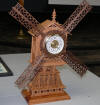

Steve Wavro - Scroll Saw Clock
Steve Wavro departed
from his usual intarsia work to craft this fretwork clock of walnut and
cherry intended as a Christmas present for his daughter who recently
married a Dutchman. Steve
explained how he had to make adjustments to the measurement to the
pattern with overseas dimensions to accommodate the clock and the
moving parts. The pattern
came from a scroll saw magazine.
|
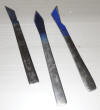 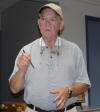

Mike Turner - Marking KnivesWhile visiting a resale
shop Mike Turner became inspired to craft layout and marking knives from
standard kitchen knives. The
blades are
blued rather than
tempered.
Mike explained how he adapted a pattern from the
Internet that can be used for crafting simple models of the Space
Shuttle.
|
|
 
Mark Womack - Bench
Following an existing plan rather than creating a design using
SketchUp, Mark Womack made this
bench for his niece to place under her window.
Mark used poplar and plywood with
a walnut top and then assembled with pocket screws.
Mark used a mallet to drive 3/8 dowels into the pocket hole
spaces then used a flush-cut saw to cut away excess.
|
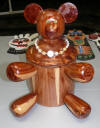 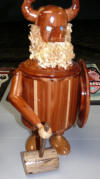
  
John Gay - Beads of Courage BoxesUsing new sewer
pipe
John Gay crafted these boxes for the
Beads of Courage program.
Seniors, at a special senior center, did the painting.
The Viking and teddy bear are crafted from aromatic cedar.
For the Viking’s beard John used a mixture of potpourri and cedar
shavings from a lathe.
|
 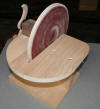
  
Denis Muras - Dominoes and Pen Maker ToolAfter
having read an article about woodworking without power tools for persons
with Alzheimer’s,
Denis Muras crafted a hand-operated disk sander that
can be used for sanding pens.
Denis showed various other jigs that can be used to make pens
without using power tools.
Denis made a set of larger and easier to see
dominoes of maple and walnut for his father then finished in a wax oil
finish. Denis explained how
he set up his drill press to drill the pips.
|
|
|
Charles Volek, WWCH Vice
President and Program Director, spoke about the deck restoration of
Galveston’s tall ship, Elissa, that occurred in 2012 and 2013.
Replacing and restoring the decking was a major
restoration project. The
project required around 9000 lineal feet of vertical 3 ½ x 5 inch
Douglas Fir, the tight grain at about 40 rings per inch. The quarterdeck
and the deckhouse had to be demolished before new decking could be
installed.
Of particular interest was the caulking of the
planks which consisted of one pass of cotton followed by two passes of
oakum. The caulking is
“horsed” into the joints using a large mallet called a beetle.
Horsing the caulking in requires just the right amount of
pressure lest you drive the caulk all the way through the joint.
The decking was then paved with Jefferies #2 marine glue (pitch).
Charles brought samples of the new deck with
materials and tools necessary to caulk between the deck planks and
showed numerous photos of the restoration as it progressed.
|
|
|
************************************************************************************************************
|
|
Photos and commentary: Gary Rowen;
Janowitz display case: David Janowitz; Wenner etagere: Larry Wenner
|
|
|
|
|
|
